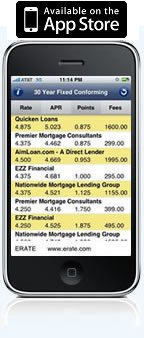Room for risk? Hybrid ARMs at 29-year lows
by Broderick Perkins
(1/21/2013) - Take another look at adjustable rate mortgages (ARMs), especially hybrids, but make it quick.
ARMs are often considered riskier than fixed rate mortgages, but if you've got a level of financial security to take on the risk, it's a prime time to leverage your home purchase or investment with an ARM.
Today's hybrid ARMs offer some of the lowest starting rates in history.
Freddie Mac's 29th Annual Adjustable-Rate Mortgage Survey of prime loans says hybrid AMS are at their lowest interest rate levels since Freddie Mac began tracking them 29 years ago — nearly three decades.
Some experts say mortgage rates should be even lower and are likely to fall in 2013.
However, if the economy continues to rebound this year, that could force rates higher.
Economic improvements have already prompted some members of the Federal Reserve to discus backing off efforts that have help pushed hybrid ARM and other interest rates to record lows.
Hybrid ARMs have an initial fixed-rate period - generally three, five, seven and 10 years - and then adjust annually thereafter.
The initial ARM period is virtually always lower than a fixed rate mortgage, giving the borrower more borrowing power or a smaller mortgage payment.
Freddie Mac's Jan. 17 Weekly Primary Mortgage Market Survey reported the average fixed rate on 30-year conforming mortgages came in at 3.38 percent, compared to 2.67 percent for the 5/1 ARM and 2.57 percent for the 1/1 ARM.
ARMs are best suited for those who know their income will grow to keep pace with any upward rate adjustments or for those who don't plan on staying in the home much longer than the initial rate period.
In a level or growing housing market, ARMs typically adjust up. However, many homeowners who took on an ARM five to 10 years ago have seen their rates fall with the housing market and, more recently, with Federal Reserve pressure to keep rates low.
"Homebuyers (and refinancing homeowners) have shied away from ARMs, particularly 1-year ARMs, because they are wary of the risk and uncertainty. In addition, fixed-rate loans currently carry rates near historic lows, and only a small amount above initial rates on ARMs," said Frank Nothaft, vice president and chief economist, Freddie Mac.
Freddie Mac's survey said the 5/1 hybrid was, hands down, the most common hybrid, followed by the 3/1, 7/1 and 10/1 hybrids. Also available, but far less common were ARMs with a re-pricing frequency fixed for the life of loan, such as a 3/3 ARM, which adjusts once every three years.
In early January 2013, the interest rate savings for the 5/1 hybrid ARM with a 30-year term, compared to the 30-year fixed-rate mortgage amounted to about 0.65 percentage points, Freddie Mac reported.
For a $250,000 loan, the monthly payment on a 5/1 hybrid would be almost $90 less than on the 30-year fixed-rate loan over the first five years of the loan.
However, the largest declines in initial interest rates among hybrid ARMs were for the 7/1 and 10/1 hybrids, where initial fixed-rates declined by 0.32 and 0.57 percentage points, respectively.
Freddie Mac's report also said, among the 131 ARM lenders surveyed, 69 percent offered loans tied to Treasury yields, up from 65 percent in 2012.
The remaining offered products tied to the London Interbank Offered Rate (LIBOR). LIBOR-indexed ARMs generally had a lower margin (about 0.5 percentage points lower) than Treasury-indexed ARMs - a similar initial interest rate, but a higher fully indexed rate.
The higher fully indexed rate reflects the fact that one-year LIBOR yields averaged 0.7 percentage points above one-year Treasury yields in early January, Freddie Mac said.
Nothaft said, "During 2012, ARMs comprised one-in-ten new home-purchase loans, according to the Federal Housing Finance Agency. We are expecting ARMs to gradually gain back some favor with mortgage borrowers, with the ARM share rising to 12 percent of the home-purchase market in 2013."
Other related articles:
20.6 million homeowners are mortgage free - for better or for worse
Low interest rates contributing to tight lending standards
First-time home buyers not always enjoying full benefits of housing recovery
Mortgage shoppers still leaving money on the table
Refinancing homeowners rushing out of ARMs, into shorter term loans
Why FRMs are strong and ARMs are weak
Fannie Mae & Jumbo Mortgage Rates
Just One Click! = Current Rate Chart

Start by selecting your state

Broderick Perkins
Home equity line of credit vs. home equity loan
Realty agents offer buyers pre-purchase credit, mortgage tips
Continued partisan attempts to undermine the CFPB victimize mortgage
Larger down payment crucial in today's low-inventory, multiple-offer housing market
Site to See: Freddie Mac's CreditSmart
Online mortgage videos a good mortgage news
Consumer Financial Protection Bureau may not be enough to clean up mortgage
How much home will the median price buy?
High-cost areas benefitting from jumbo loan boom
Mortgage credit slowly loosening, but many restraints still in place
Mortgage co-signing not what it used to be
Inside the lessons of homeownership counseling
What's to learn from homeownership counseling?
What can you do about higher FHA loan costs? Not a lot
Fundamentals apply when applying for a mortgage
Larger down payment prompts lender, seller largess
Erate Update: Which Way Mortgage Rates?
Mortgage banker vs. mortgage broker
The true cost of homeownership
No-marriage mortgages between couples are red flag parades
How much house will a conforming loan buy?
Real estate agents' role in the mortgage application process
Refinancing: Selecting a Loan

- Mortgage Program Options
- Interest Only Mortgage
- 100% Mortgage Financing - No Down Payment
- Mortgage Rates Comparison
- Search for Mortgage Rates
- No Costs Mortgage Refinancing
- 2% Rule - Refinancing Mortgage
- Yield Spread Premium
- Prepayment Penalty - Mortgage Refinancing
- What is APR and how is it calculated?
- Private Mortgage Insurance - Refinancing
Moving Ahead With Your Refinance
Get the Updated and Improved Mortgage Rates App from ERATE.com
FREE Mortgage Rate WidgetsYour State's Rates or National Rates Get this Widget for any State you want


